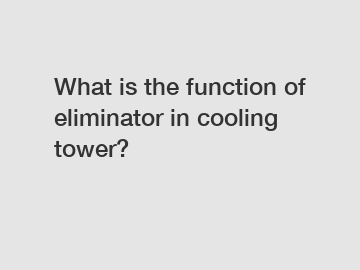What is the function of eliminator in cooling tower?
What is the Function of Eliminator in Cooling Tower?
Cooling towers play a crucial role in various industries by removing heat from industrial processes and dissipating it into the atmosphere. They are essential for maintaining the temperature of machinery and equipment, ensuring their optimal performance and longevity. While there are several components within a cooling tower, one of the most vital ones is the eliminator. In this article, we will explore the function of an eliminator and its significance in the overall functioning of a cooling tower.
Before we delve into the role of an eliminator, let's briefly understand the basic working principle of a cooling tower. Cooling towers are heat rejection devices used to cool water or other process fluids by bringing them into contact with air. They operate on the principle of evaporative cooling, where a small portion of the water undergoes evaporation, which removes heat from the remaining water stream. This cooled water is then recirculated back into the industrial processes, while the heat is released into the atmosphere.

The Role of an Eliminator.
An eliminator, also known as a drift eliminator, is a critical component in cooling towers that helps reduce the loss of water through entrainment. Entrainment refers to the process in which small water droplets become entrapped in the cooling tower's exhaust air due to the air movement within the tower. The eliminator aids in capturing and removing these entrained droplets, preventing their escape along with the exhaust air. .
Efficiency and Cost Benefits.
The primary function of an eliminator is to enhance the efficiency of the cooling tower. By capturing and returning entrained droplets back into the tower, it minimizes the water loss and ensures that only hot air is expelled. This results in significant cost savings by reducing water consumption and conserving resources.
Furthermore, an effective eliminator helps maintain the design specifications of a cooling tower. When water droplets escape along with the exhaust air, it can lead to potential issues such as water wastage, increased energy consumption, and environmental concerns. By utilizing an eliminator, these problems are mitigated, ensuring that the cooling tower operates optimally while adhering to environmental regulations.
Types of Eliminators.
There are different types of eliminator designs, each tailored to specific cooling tower configurations and requirements. Some of the commonly used eliminator designs include chevron blade, cellular drift eliminators, and wave-formed sheets. These designs vary in terms of efficiency, pressure drop, and fouling resistance. The selection of the eliminator largely depends on factors such as air velocity, the size of the water droplets, the cooling tower's operating conditions, and the industry's specific needs.
Maintenance and Cleaning.
To ensure the efficient functioning of an eliminator, regular maintenance and cleaning are essential. Over time, the eliminator can accumulate dirt, debris, and mineral deposits. This can lead to reduced efficiency, increased pressure loss, and potential damage to other components of the cooling tower. Regular inspection and cleaning of the eliminator are crucial to remove any obstructions and maintain its optimal performance.
In conclusion, the eliminator plays a crucial function in cooling towers by reducing water loss through entrainment. It helps maintain the efficiency and design specifications of the cooling tower, resulting in cost savings, resource conservation, and compliance with environmental regulations. With different eliminator designs available, careful selection and regular maintenance are vital for ensuring its optimal performance. If you have any further questions or require assistance with cooling towers, please feel free to contact us.
Contact Us.
If you want to learn more, please visit our website vinyl seawall panels near me, diffuser fine bubble, membrane diffuser product.
More articles:
Which fill is best for cooling tower?
155
0
0


Comments
All Comments (0)